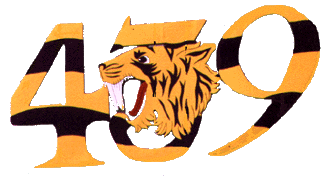|
History
of
 Squadron Squadron
  
Chapter
VII
The Advance to the Rhine
February
- March 1945
The next six days were a reversion to the normal Dutch winter weather of heavy ground haze which prevented flying except during one brief clearing on the afternoon
of 16 February.
Four operations were crowded into those three hours
with good results. Three attacks on rail lines yielded five cuts, one by F/L Shaver's trio near Borken, another by F/O McBride's section between Groenlo and Winterswijk, and three (particularly good bombing) by S/L Beatty, F/Os Kubicki and Cleghorn between
Enschede and Ahaus. On the last attack the three pilots met considerable light flak but it did not affect their aim as they
dived to 1000 feet to release their loads. The fourth operation that day was an innovation for the Typhoons, a wing show directed against a V.l site at Puttershoek, west of Dordrecht, an area far west of the wing's normal zone of operations. In a sky surprisingly
clear of flak the aircraft went down in a steep dive which yielded a good concentration of bomb bursts. The target was believed to be destroyed, but the squadron reported it as a
"photo finish", pending photographic assessment.
|
Intentionally
left blank
|
Intentionally
left blank
|
The period 21 to 25 February provided a sharp contrast to the previous week. On four of the days the weather was almost perfect and operations soared to a new peak: seven shows on the 21st (32 sorties), thirteen (52 sorties) on
the 22nd, and, after an off day, nine more on the 24th (39 sorties) and seven (32 sorties) on the 25th; all of which added up to almost one half of the month's work (36 operations out of 80, and 155 sorties of 354) on four flying
days! The results were equally impressive. Seven of the sorties made no claims, but the others reported 59 rail cuts, three road cuts, three flat cars destroyed, two tanks and an armoured vehicle destroyed, a switch house destroyed, two V.l sites, two freight cars, a bridge and a horse drawn vehicle damaged.
The series began with another wing attack upon two V.1 sites near Rotterdam. No. 181 Squadron went in first to rake the flak posts with
rockets, and No.440 followed up with anti personnel bombs. Then, the guns having
been almost silenced, No.439 and 438 dive bombed the two sites with well concentrated bursts. All the other sorties on the 21st were for rail interdiction with cuts being made near
Geldern, north of Borken, west of Enschede(two cuts),(1) north of Munchen Gladbach, south east of Geldern, and north of Dorsten. In one attack F/O Walt Kubicki saw his bombs hit and damage three freight cars that were standing on a siding beside the main line. Bounces by other Allied aircraft caused
"a bit of consternation"
on two sorties before identities were clarified.
(1) While assessing the results of this attack, the pilots noticed that the rails had been removed from a considerable section of the branch line. Because of shortage of rails for repair work
on the Reichsbahn, the enemy apparently was "cannibalising" the secondary tracks.
|
|
On the 22nd activities began at 0920 and continued until 1800 hours. At one period the squadron had 16 of its aircraft in the air! One formation had to jettison its bombs when the target area was wholly obscured by clouds, but the other twelve carried out attacks that resulted in 28 cuts on nine rail lines and a crater in one road. F/L Shaver led off with a remarkable score of five cuts near
Geldern, in the battle area; the bombs also destroyed a flat car and an
A.F.V. parked on a siding. F/O Bill Davis and S/L Jim Beatty reported identical results for their sections, two rail cuts and
two near misses, near Wesel and south of Borken. F/O Al McBride also got two cuts when his section bombed a train at issum, east of
Geldern. The train consisted of seven flat cars each carrying a tank. Direct hits caused large explosions which set fire to some of the cars. When the debris settled it was seen that two cars and two tanks had been destroyed. Lyal Shaver, leading his second show, blew three more cuts in the Coesfeld Ahaus line, and strafed a
large horse drawn truck.
Then Bill Davis bombed the Coesfeld Burgsteinfurt tracks, missing the rails, but blasting a road nearby. The next two sorties claimed no hits; the visibility was rather bad. Lyal Shaver reopened the scoring with three cuts in the
rails
between Gronau and Langenhorst; and "Wee Willie" Davis got three more plus two near misses east of Deventer; after which Jim Beatty's section blew two craters in the line near Haltern. Finally, to end the long day, Bill Davis, Walt Kubicki, Vic Le Gear and Len Horrocks dive bombed the tracks midway between Geldern and Wesel.
Three pairs of bombs blew six craters in two rails.
  
Copyright
©1998-2016 Michael T. Melnick. All rights reserved
the
unofficial homepage of  Tiger
Squadron Tiger
Squadron
.
.
|
|